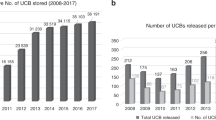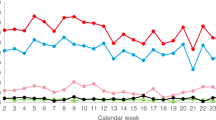Abstract
Over the past decade umbilical cord blood (UCB) has been increasingly used as a source of haematopoietic stem cells (HSCs) for patients who require a HSC transplant but do not have an HLA-matched donor. It was anticipated that using UCB as an alternative source of HSCs would increase the chance of finding a donor, particularly for the otherwise underrepresented ethnic minority groups. To evaluate the effectiveness of the Australian public UCB banks to increase the ethnic diversity of available HSC donations, this paper analyses the ethnic diversity of the Sydney Cord Blood Bank (SCBB), comparing this diversity to that of the Australian Bone Marrow Donor Registry (ABMDR). It also examines the ethnic diversity of those patients who, after requesting a haematopoietic stem cell transplantation in the 2-year period between 2003 and 2005, managed to find a suitably matched bone marrow or UCB donor. We show that the ethnic mix of donors to the SCBB has remained generally broad in source, is comparative to the Australian population, and is more diverse than the ABMDR. This, however, may still not be sufficient to substantially increase the likelihood of finding a donor for some ethnic minority groups.
This is a preview of subscription content, access via your institution
Access options
Subscribe to this journal
Receive 12 print issues and online access
$259.00 per year
only $21.58 per issue
Buy this article
- Purchase on Springer Link
- Instant access to full article PDF
Prices may be subject to local taxes which are calculated during checkout
Similar content being viewed by others
References
Bone Marrow Donors Worldwide, 2006; available at http://www.bmdw.org/. Accessed November 2006.
Tse W, Laughlin MJ . Umbilical cord blood transplantation: a new alternative option. Hematology (Am Soc Hematol Educ Program) 2005; 1: 377–383.
Petterson TE, Tiedemann K, Teague L, Shaw P, Baker D, Balton-Jones R et al. Outcome following unrelated cord blood transplant in 136 patients with malignant and non-malignant disease: a report from the Australian and New Zealand Children's Haematology & Oncology Group (ANZCHOG). Biol Blood Marrow Transplant 2006; 12 (Suppl 1): 20.
Rocha V, Cornish J, Sievers EL, Filipovich A, Locatelli F, Peters C et al. Comparison of outcomes of unrelated bone marrow and umbilical cord blood transplants in children with acute leukemia. Blood 2001; 97: 2962–2971.
Rubinstein P, Carrier C, Scaradavou A, Kurtzberg J, Adamson J, Migliaccio AR et al. Outcomes among 562 recipients of placental-blood transplants from unrelated donors. N Engl J Med 1998; 339: 1565–1577.
Rocha V, Labopin M, Sanz G, Arcese W, Schwerdtfeger R, Bosi A et al. Transplants of umbilical-cord blood or bone marrow from unrelated donors in adults with acute leukemia. N Engl J Med 2004; 351: 2276–2285.
Laughlin MJ, Eapen M, Rubinstein P, Wagner JE, Zhang MJ, Champlin RE et al. Outcomes after transplantation of cord blood or bone marrow from unrelated donors in adults with leukemia. N Engl J Med 2004; 351: 2265–2275.
Barker JN, Weisdorf DJ, DeFor TE, Blazar BR, McGlave PB, Miller JS et al. Transplantation of 2 partially HLA-matched umbilical cord blood units to enhance engraftment in adults with hematologic malignancy. Blood 2005; 105: 1343–1347.
Australian Government: Department of Health and Ageing. Good health for life—childhood health measures, 2000; available at http://www.health.gov.au/internet/wcms/publishing.nsf/content/health-budget2000-fact-hfact2.htm. Accessed November 2006.
Kunz C, Costello L . 2001 Census: ancestry—detailed paper (census paper no. 03/01b). Australian Bureau of Statistics, 2003; available at http://www.ausstats.abs.gov.au/ausstats/subscriber.nsf/0/AD2222ECE5AD4396CA25712500161734/$File/29330_2001.pdf. Accessed December 2006.
Price C . Australian population: ethnic origins. People Place 1999; 7: 12–16.
Australian Bone marrow Donor Registry 2006; available at http://www.abmdr.org.au/. Accessed November 2006.
Acknowledgements
We thank the Australian Bone Marrow Donor Registry and the Sydney Cord Blood Bank for their helpful cooperation.
Author information
Authors and Affiliations
Corresponding author
Rights and permissions
About this article
Cite this article
Samuel, G., Kerridge, I., Vowels, M. et al. Ethnicity, equity and public benefit: a critical evaluation of public umbilical cord blood banking in Australia. Bone Marrow Transplant 40, 729–734 (2007). https://doi.org/10.1038/sj.bmt.1705812
Received:
Revised:
Accepted:
Published:
Issue Date:
DOI: https://doi.org/10.1038/sj.bmt.1705812
Keywords
This article is cited by
-
High quality cord blood banking is feasible with delayed clamping practices. The eight-year experience and current status of the national Swedish Cord Blood Bank
Cell and Tissue Banking (2016)
-
Cord blood banking – bio-objects on the borderlands between community and immunity
Life Sciences, Society and Policy (2015)
-
Ethnic minorities, bone marrow, and cord blood
Nature Reports Stem Cells (2007)



